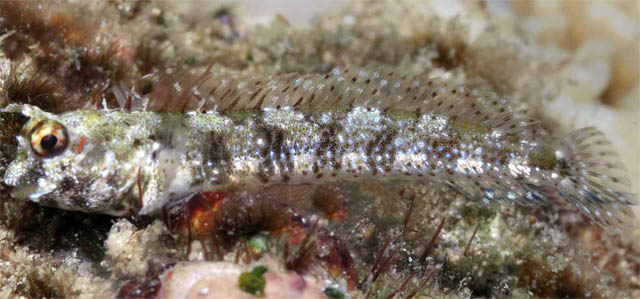Dr. William Smith-Vaniz of the University of Florida and Dr. Gerald Allen of the Western Australian Museum have discovered a new species of diminutive blenny fish near the Andaman Islands, Indian Ocean.

Alloblennius frondiculus (G. R. Allen)
A paper in the journal Zootaxa describes the species, called Alloblennius frondiculus, on the basis of one female specimen measuring 23.8 mm (0.9”) in body length.
It was found near the shore of South Cinque island, which lies just to the south of the main Andaman Islands.
“The type locality was situated next to shore along a wave-exposed coast in 0–3 m depth,” the researchers wrote in the paper. “The bottom consisted of large algal-covered boulders in an area of very strong surge.”
Until now, the genus Alloblennius has included four species: A. jugularis, A. pictus, A. parvus and A. anuchalis.
“It differs from other species of Alloblennius in having a pinnately branched supraorbital cirrus about equal to eye diameter in height, lower jaws with relatively large, darkly pigmented labial flap anteriorly on each side of chin, pectoral fin with 10 or 11 distinct, small dark spots; and anteriormost preopercular pore position with a vertical pair of pores,” the researchers described.
The species name frondiculus means “a small leaf” in Latin and refers to the shape of its orbital cirrus.
“Sides of body with six evenly spaced, brown bands, weakly connected to olive saddles, including an olive blotch on dorsal half of caudal peduncle; remainder of sides pale olive becoming white ventrally with dense sprinkling of small white spots, replaced by irregular, double row of orange-brown spots ventrally,” the researchers described the coloration of the species in detail.
“Head pale white to olive with a few irregular dusky blotches and a narrow, reddish postorbital bar. Dark bar, wider ventrally, extending from lower front corner of eye across middle of upper jaw, posterior end of upper jaw white.”
“Iris yellow with about six reddish-orange bars radiating from pupil. Dorsal fin with black submarginal spot between first two spines, remainder of fin pale with scattered white spots and small brown spots or dashes centered on rays, forming diagonal rows posteriorly. Caudal fin mostly pale with several rows of brown bands alternating with narrower white spots on rays.”







